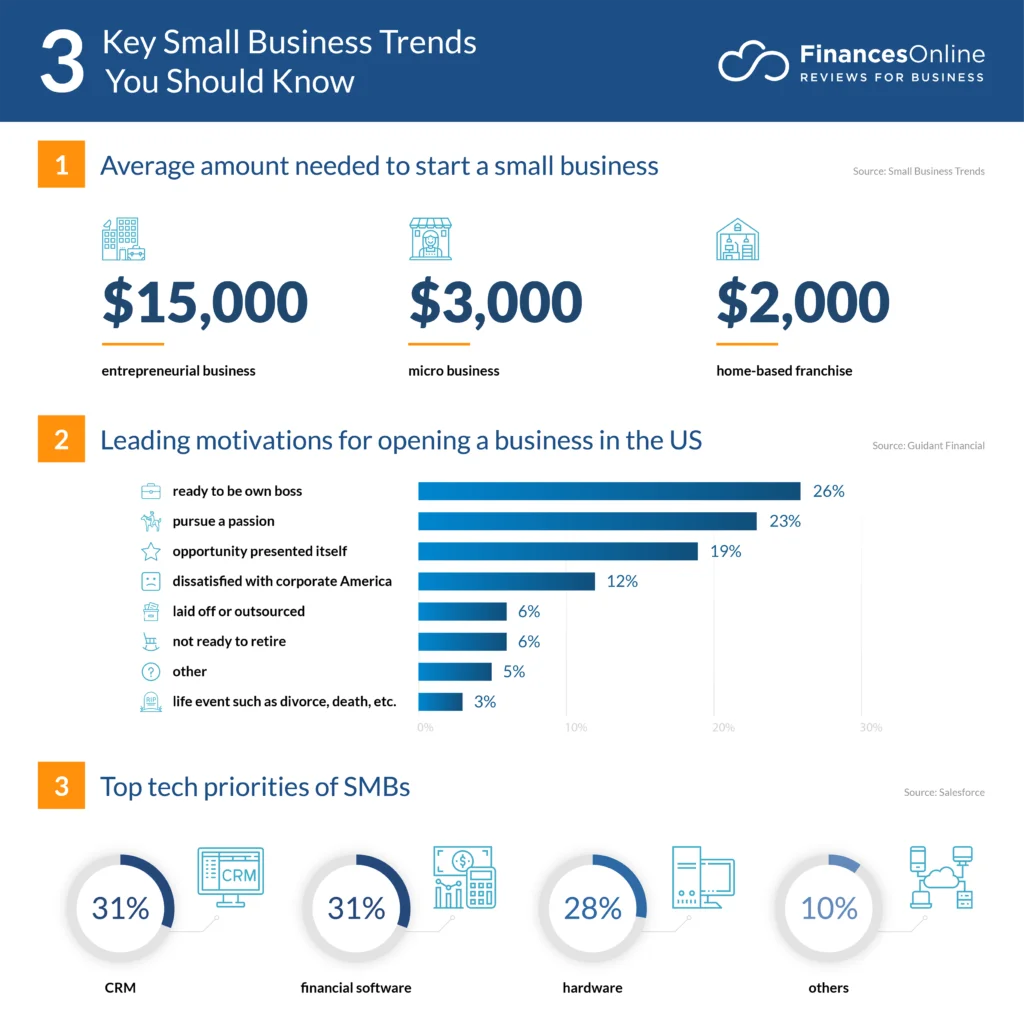Spot Business Trends Early: A Guide to Stay Ahead and Grow Your Small Business in 2024
Spotting business trends before they become mainstream isn’t just a skill—it’s a competitive advantage. Early adopters can shape their strategies around what’s coming, while others scramble to catch up. By knowing where to look and how to interpret signals like consumer behavior, industry movements, or even fleeting social moments, you can position yourself ahead of the curve. In this post, we’ll explore actionable ways to recognize patterns early and ensure your small business thrives in an ever-changing market.
Understanding Business Trends
Business trends represent patterns or shifts in the way industries, markets, or consumer behaviors evolve. For small businesses, trends are like a compass, pointing toward opportunities that can lead to growth or risks that might threaten sustainability. By learning how to interpret these signals effectively, you can stay ahead of competitors, adapt quickly, and ensure long-term success.
Stay Informed: Sign Up for Our Blog
Micro vs. Macro Trends: Differentiate Between Micro Trends and Macro Trends
Micro and macro trends are the two main forces shaping business landscapes daily. Understanding their differences helps pinpoint where to focus efforts and resources.
What Are Micro Trends?
Micro trends are short-term patterns that frequently appear within specific industries or consumer groups. These can last from a few weeks to months, often emerging from niche consumer interests, social media trends, or specific seasonal demands.
For example:
- A surge in demand for a new type of coffee drink.
- Trending hashtags or viral challenges, like TikTok dances linked to brands.
Micro trends are highly reactive and often fade as quickly as they appear. Businesses looking to capitalize on these need to act fast. For instance, in fashion, certain styles become “must-haves” for a season but can go out of vogue just as quickly.
What Are Macro Trends?
Macro trends, on the other hand, are long-term shifts that redefine industries and consumer behavior over years or even decades. Think of them as the “big picture” of how society evolves concerning technology, culture, economy, or environment.
Some examples of macro trends include:
- The growing prioritization of sustainability, influencing product design and supply chains.
- Wider adoption of AI and automation across industries.
- The ongoing movement toward remote working and hybrid job models.
Macro trends are slower-moving but have deeper, transformative impacts. For instance, the gradual replacement of fossil fuels with renewable energy sources is a macro trend affecting many industries simultaneously.
Why the Difference Matters
Recognizing whether a trend is micro or macro helps you set the right expectations. Micro trends are about quick reactions—capitalize while the moment is hot. Macro trends, however, demand strategic planning, investing in resources that align with the big changes coming down the road.
If you’re still asking, “Where do I find these trends?” start by observing platforms like Trend Hunter or by analyzing industry-specific reports, like those from McKinsey. These sources provide insights into both emerging micro and macro movements.
By distinguishing between these two types of trends, you can develop a balanced approach—acting on micro trends while simultaneously gearing up for macro shifts that secure your business’s future.
image by financesonline.com
Utilizing Data Analysis Tools
To understand and predict emerging trends for your small business effectively, leveraging data analysis tools is indispensable. These tools act as the compass that guides your decision-making, ensuring you remain two steps ahead of change rather than reacting to it. By analyzing key metrics from your website and social media platforms, you can identify patterns that signal upcoming trends.
Website Analytics: Identify Trend Signals Through Activity Indicators
Your website is more than a digital storefront—it’s a goldmine of insights waiting to be uncovered. Website analytics tools reveal what visitors are doing, what they’re looking for, and even what’s missing from your offerings. But how do you turn all those metrics into actionable insights?
Start by paying attention to behavioral metrics like page views, session duration, and click-through rates. If certain product categories or blog posts are seeing sudden spikes in interest, that’s a clue. For instance, a sharp rise in searches for “sustainable packaging” or page clicks on eco-friendly products could point to a growing demand for environmentally conscious solutions.
Another critical indicator is geographic data. Are you noticing increased traffic from a specific region? This could hint at localized trends worth tapping into. For example, if your analytics show an influx of visitors from Seattle viewing your winter gear, targeting that region with tailored ads might boost sales.
Using trusted website analytics tools like Google Analytics or MonsterInsights can simplify the process, helping you zero in on these patterns. These tools also highlight where you’re losing visitors, flagging areas for improvement.
Social Media Analytics: Harness Metrics to Spot Cultural Shifts
Social media analytics is your window into the collective mood of your audience. Platforms like Instagram, Facebook, and Twitter are not just for engaging consumers—they’re treasure troves of data that reveal what people are buzzing about.
Keep a close eye on metrics like engagement rates (likes, shares, comments) and hashtag popularity. For example, if the hashtag #MinimalistLiving suddenly gains traction, it could indicate a shift towards minimalism in consumer lifestyles. Such insights can inspire product lines, marketing strategies, or even partnerships.
Monitoring audience demographics is equally essential. Tools like Hootsuite allow you to track who engages most with your posts. Are younger audiences interacting more with certain content types? This might suggest an emerging trend among Gen Z consumers.
Additionally, sentiment analysis helps gauge public perception. Platforms like Brandwatch or Sprout Social can uncover whether chatter about your industry is positive, negative, or neutral. This context is crucial to positioning your business and aligning with consumer expectations.
image by Kindel Media
By combining insights from both website and social media analytics, you can triangulate trends early, pivot strategies swiftly, and ensure your small business always stays ahead of the curve.
Leveraging Consumer Feedback
When it comes to identifying upcoming small business trends, consumer feedback is one of your most reliable resources. Think of it as a direct line to your audience’s wants, needs, and frustrations. By leveraging this information effectively, you can develop services, products, or marketing strategies that align perfectly with shifting preferences.
Surveys and Polls: Understanding Consumer Sentiments with Precision
Surveys and polls are not just about asking questions—they’re a window into your customers’ minds. When structured correctly, they reveal patterns in preferences and emerging needs.
For instance, a simple survey sent out with purchase confirmations can help identify what drove customers to make their purchases—and what might have held them back at first. Including questions like, “What could we improve?” or “What product do you wish we offered?” unlocks a treasure trove of insights. Offering open-ended questions gives respondents the freedom to share more detailed thoughts, which may hint at developing trends.
Surveys can be distributed through multiple channels, such as email, social media platforms, or directly on your website. Tools like SurveyMonkey provide user-friendly templates for crafting tailored questions. Short, engaging polls on Instagram Stories or Twitter can also work wonders if you’re reaching younger audiences.
Here’s a tip: Incentivize your surveys with discounts or small perks to boost participation. The small cost can more than pay for itself in real-world trend insights.
Social Listening Tools: Your Gateway to Emerging Trends
While surveys help you proactively ask for feedback, social listening tools allow you to eavesdrop on organic conversations your customers are already having. This isn’t as sneaky as it sounds—social listening involves tracking public sentiments and discussions about your brand, competitors, or industry trends.
For example, if you’re in the fitness industry, a spike in mentions of “bodyweight workouts” or “smart kettlebells” on platforms like Twitter or Reddit could signal a growing trend in minimalist home fitness. With this knowledge, you can tweak marketing strategies or invest in new product lines before competitors do.
Social listening tools such as Sprinklr and Brandwatch monitor conversations across platforms, analyze sentiment, and highlight trending keywords. These tools use AI to aggregate and interpret large quantities of social data, simplifying your hunt for trends. Some even have nifty features like image recognition, which can reveal how customers are showcasing your products in real life.
Not sure where to start? Platforms like Sprout Social integrate seamlessly with your existing social media accounts, enabling you to track conversations in real-time.
Social listening is especially effective for spotting nano trends—those hyper-short-term buzz points often overlooked by reports. Keep an eye on hashtags, memes, and viral posts. Even if some fizz out quickly, others may point to deeper cultural shifts.
By utilizing both structured surveys and responsive social listening, you make consumer feedback not only a way to solve existing issues but also a predictive tool that keeps you ahead of the curve.
Monitoring Industry Influencers and Leaders
Keeping tabs on industry influencers and leaders is not just about staying informed; it’s about staying ahead. These individuals shape trends, influence consumer behavior, and often act as early adopters of what’s next. By learning to monitor their activities effectively, you can position your small business to capitalize on emerging trends before they gain mainstream traction.
Social Media Influencer Trends
Influencers are the trendsetters of the digital world. They have the audience, the voice, and the ability to make or break trends. But how can you leverage their insights without falling into the noise?
Start by identifying influencers in your niche. Platforms like Instagram, LinkedIn, and TikTok are fertile grounds for discovering voices that resonate with your target audience. Tools like Influencer Monitoring Tools help track influencer activities, including their posts, partnerships, and the types of conversations they’re fostering.
image by Freepik
Here’s how to monitor effectively:
- Follow Consistently: Regularly check what influencers in your sector are talking about. Are they promoting eco-friendly products? Talking about AI solutions? Their posts often signal where consumer interest is heading.
- Engage Thoughtfully: Comment and interact with influencers’ content where appropriate. This not only builds rapport but keeps you in the loop of their conversations.
- Analyze Engagement: Look at which posts are getting the most likes, shares, and comments. High engagement on a particular topic can indicate growing consumer interest.
For example, if a tech influencer is consistently discussing smart home devices, it might be a clue that this market niche is about to boom. Using reports from sources like Influencer and Key Opinion Leader Reports, you can stay informed on everything from emerging hashtags to campaign performance.
Beyond social media monitoring, consider signing up for industry thought leaders’ newsletters or podcasts. Unlike fleeting social posts, these formats often dive deeper into upcoming trends and can provide a strategic edge.
Competitor Analysis
Your competitors can be a goldmine of information when it comes to spotting new trends. Observing their strategies, successes, and failures is not about mimicry; it’s about understanding the direction of your industry.
Begin with a structured approach to competitor analysis by identifying both direct and indirect competitors. Direct competitors target the same audience as you, while indirect ones may serve adjacent markets but still influence your space.
Key areas to monitor include:
- Product Launches: Is a competitor investing in a new category? This could signal an underserved or emerging demand in the market.
- Marketing Campaigns: Look at their advertising. What messages are they emphasizing? Are they suddenly pushing for “sustainability” in fashion or “hybrid work models” in tech?
- Social Feedback: Check how customers respond to your competitors’ new initiatives. Positive feedback can confirm a trend’s viability, while backlash can show opportunities for differentiation.
Tools like Crayon simplify this process by offering real-time updates on competitors’ activities. You can also use government resources like the SBA’s Competitive Analysis Guide to structure this research effectively.
For instance, if your competitor starts adding plant-based options to their menu, it might signal a growing consumer interest in vegan lifestyles. By recognizing this shift early, you could develop your offerings and marketing campaigns to cater to this audience before everyone else catches on.
Monitoring both influencers and competitors is the equivalent of scanning the horizon before setting sail. It allows you to adjust your course, prepare for rough weather, or seize the wind that’s about to blow in your favor.
When combined, insights from industry leaders and competitors create a robust framework for trendspotting. They equip small businesses to not only react to trends but to shape them, ensuring you’re not just surviving the market shifts but leading them.
Conclusion: Sustaining Success Through Trend Awareness
Staying ahead of small business trends is more than just an advantage—it’s essential for thriving in today’s dynamic economic landscape. As consumer preferences shift and industries evolve, the ability to predict trends allows businesses to adapt strategies and stay relevant. Identifying these patterns requires a blend of tools, intuition, and constant observation, ensuring you’re not just keeping up but staying a step ahead.
Focus on refining your approach by combining data analytics, consumer feedback, and competitor insights. Try utilizing platforms like Exploding Topics to spot emerging trends before they peak. Additionally, keeping an eye on curated business guides, such as this Top Trends to Watch 2025, can offer valuable foresight for long-term planning.
Ultimately, maintaining a proactive mindset toward trend analysis and leveraging the right resources ensures your business stays agile and positioned for success. By integrating these best practices, you’ll not only understand the direction markets are heading but also drive innovation that leads the way.
Get in Touch
Contact me today for a FREE consultation to learn more about how easy it is it to implement cost-effective AI marketing tools for your small business. Not only will you get some free tips and tricks, we can discuss how I can help grow your business for pennies on the dollar compaired to other services. Using AI marketing, I’ve TRIPLED my small consultation business in the last 9 months – I can help you grow too. I understand small business because I am a small business.



